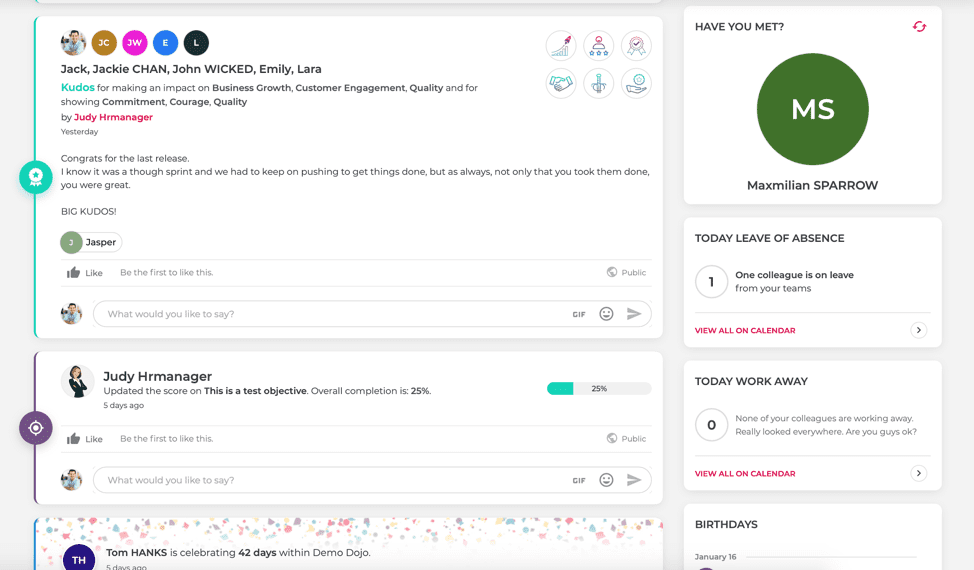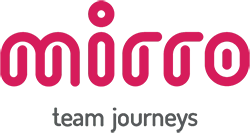Why Performance Management Needs a Social Twist

As the age of industrialism came to an end, step by step, man separated himself from machine. Emotions, as well as the desire to fulfill one’s needs, even the ones ranking highest in Maslow’s hierarchy, slowly garnered more and more interest. Thus, a worker’s performance stopped being analyzed from an exclusively quantitative perspective, i.e. the number of hours spent on a certain task. Other factors started coming into focus - for instance, how well we integrate and work in a team - since, in the words of Aristotle, we are all “social animals” and, might we add, we cannot shut down our needs during office hours, just for the sake of productivity.
According to Forbes magazine, there are at least five benefits to healthy work relationships a.k.a the social aspect of our work lives. Among these, we mention less stress, increased engagement, and loyalty, a healthier life, as well as increased happiness. Of course, simply providing people with a workplace does not imply they will take a liking to one another and the above results will automatically be achieved. There are also some methods through which these effects can be attained, and among these we will mention creating a social spot, giving people continuous reasons to celebrate, and connecting departments.
Being social in a virtual environment
However, what do we do now, that more and more people have started working remotely and some of them have not even met face-to-face? Just like social media can keep us all connected no matter the distance between us, there are ways people can connect for work purposes.
We would like to introduce the concept of Social Performance Management or SPM, in the sense of “the use of a social network platform, whether cloud-based or residing on an intranet, to optimize workplace performance and accomplish HR and talent management functions. Some of the most common applications of SPM are goal management, employee alignment and engagement, development and coaching, talent mapping and recognition”, as Best Practice Institute defines it.
Back in 2014, HR Magazine was anticipating the need for such a concept. “Successful teamwork necessitates interaction and dependencies. Given that team members are frequently scattered geographically and may never meet face to face, it’s essential to have a tool to ensure that they’re on track with their individual deliverables and that they’re knowledgeable about how the team is tracking against all of its goals. Today’s performance management processes rarely provide up-to-date information on performance that motivates and informs teams about their progress.”
Social media that boosts productivity
Yes, you read correctly - social media can boost productivity. “Inspired by social media sites such as Facebook, LinkedIn, and Yammer, SPM systems allow employees to exchange information quickly and easily, fostering ongoing dialogue, coaching, and recognition. Regardless of their level in the organization, all employees can share information ranging from goals to feedback to positive recognition,” according to HR Magazine.
SPM is, in fact, the base on which Mirro was created. The three methods of improving work relationships from Forbes, mentioned in the previous section, can all be found in Mirro, even if virtually. Thus, Mirro has a very strong social element, as it includes an activity feed, with various work-related updates posted by users, such as objectives, work anniversaries or kudos, to mention a few.

Reasons to celebrate take the form of “kudos”, a form of thank-you between colleagues, and work anniversaries, which the app “remembers” automatically. Teams are connected in Mirro through the aforementioned kudos, as well as feedback requests - thus, team members receive a 360-degree perspective of their work, and they also learn about their colleagues’ activity and achievements. The latter can also have another interesting social impact on the colleagues simply reading the updates, as they may eventually aspire to receive the same kind of recognition. Like this, we can say that Mirro also has a very strong motivational element, encouraging employees to become even better through the examples set by others.
Bogdan Ioniță, product manager at Mirro, takes the SPM concept even further, linking it to employee retention. “Nowadays, companies cannot afford to lose top talent on account of ineffective work relationships nor miss business opportunities because the workforce and management are not on the same page. Social Performance Management tools like Mirro can take an obsolete and often dreaded evaluation process and turn it into a user-friendly and fun collaborative communication tool that motivates the whole team to work better together, by giving everyone a better picture of the whole organizational mechanism and how important their part is in it.”
Another very important aspect worth taking into consideration about SPM is that it drives constant engagement, by enabling communication and collaboration on what matters most. By this, we are referring to the goals a company aims to achieve and which Mirro makes visible for everyone in the company. Like this, every team member understands the big picture, the significance of their role, as well as how important it is for members of the same team, and other teams alike, to work together.
Last but not least, SPM tools like Mirro are also a great means of feeling connected, especially in times of social distancing, and not just for productivity purposes, but even as morale boosters. Let’s think, for example, about the need for entertainment brought by the social element in our work lives. Just like employees take the occasional coffee break, go to lunch together, or participate in team-building activities, performance management works better if it’s a bit more fun and casual. By mirroring various social networks that we all take pleasure in checking every now and then, Mirro has implemented a simple feature: people can comment on kudos and work anniversaries, by writing a message and making it more fun through the use of emojis and gifs. Work becomes a bit more fun like this, and SPM helps people feel connected even when apart.
To conclude, SPM tools work best when combined with other efforts for engagement. For example, the Mirro team has regular online improv games like word association or collaborative stories, during which we get to know each other better and build stronger connections. We also occasionally hold virtual coffee breaks in the morning and even the casual after-work beer
How do you make your work life more social during these times? We’d love to read about your experiences in the comment section below.




